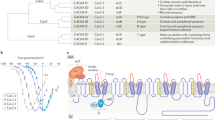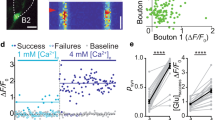Abstract
A BASIC step in the functioning of chemically operating synapses is the effect of the transmitter substance on the postsynaptic membrane. Although in some synapses the transmitter acts on ion “pumping” mechanisms1, perhaps the most common mode of action of a transmitter is the opening of additional ionic pathways in the postsynaptic membrane2. The study of these changes in permeability is of importance because it can throw some light on the nature of the transmitter. An important aspect of such a study is the measurement of the equilibrium potential of transmitter action; that is, the level of membrane potential which exactly balances the electromotive forces of the ionic pathways opened by the transmitter, and at which the synaptic potential is zero. Beyond this level the synaptic potential is reversed in direction.
This is a preview of subscription content, access via your institution
Access options
Subscribe to this journal
Receive 51 print issues and online access
$199.00 per year
only $3.90 per issue
Buy this article
- Purchase on Springer Link
- Instant access to full article PDF
Prices may be subject to local taxes which are calculated during checkout
Similar content being viewed by others
References
Lundberg, A., Physiol. Rev., 38, 21 (1958).
del Castillo, J., and Katz, B., J. Physiol., 125, 546 (1954).
Ginsborg, B. L., Pharmac. Rev., 19, 289 (1967).
Katz, B., and Miledi, R., Nature, 207, 1097 (1965).
Katz, B., and Miledi, R., J. Physiol., 192, 407 (1967).
Miledi, R., J. Physiol., 192, 379 (1967).
Bloedel, J., Gage, P. W., Llinás, R., and Quastel, D. M. J., Nature, 212, 49 (1966).
Kusano, K., Livengood, D. R., and Werman, R., J. Gen. Physiol., 50, 2579 (1967).
Armstrong, C. M., and Binstock, L., J. Gen. Physiol., 48, 859 (1965).
Burke, W., and Ginsborg, B. L., Physiol., 132, 599 (1956).
Miledi, R., and Slater, C. R., J. Physiol., 184, 473 (1966).
Hodgkin, A. L., Proc. Roy. Soc., B, 148, 1 (1958).
Author information
Authors and Affiliations
Rights and permissions
About this article
Cite this article
MILEDI, R. Transmitter Action in the Giant Synapse of the Squid. Nature 223, 1284–1286 (1969). https://doi.org/10.1038/2231284a0
Received:
Issue Date:
DOI: https://doi.org/10.1038/2231284a0
This article is cited by
-
Neurotransmitters of cephalopods
Invertebrate Neuroscience (1996)
-
Fine structure of synaptic contacts in the first order giant fibre system of the squid
Zeitschrift f�r Zellforschung und Mikroskopische Anatomie (1971)
-
Biological Sciences: Transmitter Release by Presynaptic Impulses in the Squid Stellate Ganglion
Nature (1970)
Comments
By submitting a comment you agree to abide by our Terms and Community Guidelines. If you find something abusive or that does not comply with our terms or guidelines please flag it as inappropriate.



